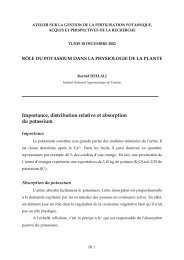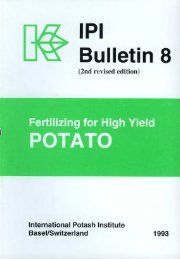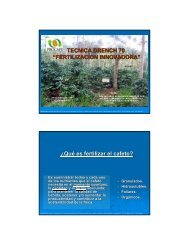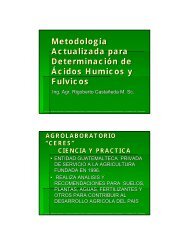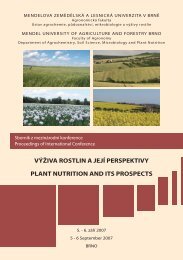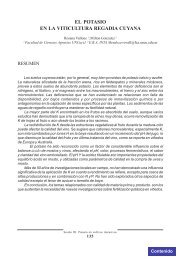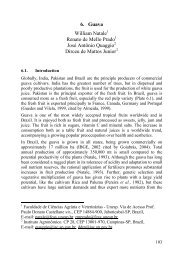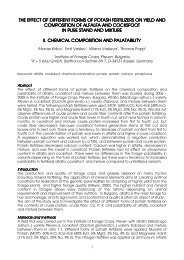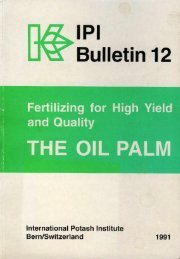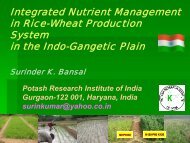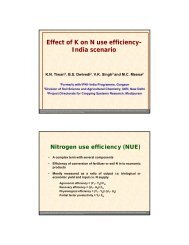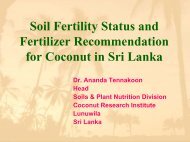Potassium Research and Agricultural Production - The International ...
Potassium Research and Agricultural Production - The International ...
Potassium Research and Agricultural Production - The International ...
Create successful ePaper yourself
Turn your PDF publications into a flip-book with our unique Google optimized e-Paper software.
for certain industrial crops a minor increase in the cultivated area is envisaged, a<br />
substantial increase of yields by the modernization of production is recognized to be<br />
of primary importance in these branches too. An important task is to increase the<br />
productivity of the agricultural areal. This means: further modernization of the<br />
biological bases, improved efficiency in the use of chemicals, development of the<br />
technico-material background, in a word: intensive development.<br />
Experiences gained with up-to-date complex technologies, employed in cereal <strong>and</strong><br />
maize production systems, have unambiguously proved that the substantial reserves<br />
hidden in the agricultural production are quickest exploited by systems assuring<br />
the integration of the production factors. <strong>The</strong>refore in all major branches of crop<br />
production we endeavour to develop complex technological systems <strong>and</strong> propagate<br />
them as widely <strong>and</strong> quickly as possible.<br />
Further on 1 wish to inform you about the tendencies of fertilizer use in Hungary, its<br />
present conditions, problems <strong>and</strong> our development objectives.<br />
Prior to the World War Il fertilizer use in our crop production was insignificant.<br />
Characteristically, in 1938 2.2 kg active agent per hectare cultivated area were used.<br />
<strong>The</strong> use of chemicals increased with the development of the socialist large-scale farms.<br />
After 1960 the opportunity was given to apply up-to-date technics <strong>and</strong> professional<br />
knowledge on a higher level. <strong>The</strong> first phase of development - between 1960 <strong>and</strong> 1970was<br />
characterized by increasing quantities of fertilizers applied. During those ten<br />
years the total amount of fertilizer active nutrients applied per hectare cultivated<br />
area grew from 29 to 150 kg, that is more than five times, <strong>and</strong> the amount of pesticides<br />
applied increased by more than three times. <strong>The</strong> utilization of synthetic materials - primarily<br />
for protected crops which was negligible in 1960 - exceeds 6(x)() tons in 1970. In<br />
addition to the quantitative increase even the assortment was enlarged. <strong>The</strong> number of<br />
fertilizers available to farms increased from only 3 in 1960 to 15 in 1970. <strong>The</strong> number<br />
of pesticides grew from 50 to 150 in ten years. <strong>The</strong> widening range of chemicals<br />
promoted the better exploitation of the possibilities offered by chemistry.<br />
<strong>The</strong> development of fertilizer use was accelerated since 1970; at present 450-550 kg/ha<br />
fertilizer active agent is utilized in the complex industry-like crop production systems.<br />
All this shows that without a rational improvement of fertilizer utilization the other<br />
factors of yield increase - variety, machines, etc. - cannot be sufficiently effective.<br />
In 1973 the amount of fertilizer active agent exceeded 171 kg per hectare agricultural<br />
area in Hungary. We reckon with a further increase, so fertilizer utilization may<br />
attain 217 kg/ha by 1975, <strong>and</strong> 298 kg/ha by 1980.<br />
To ensure the fertilizer quantities required for attaining high yields is an important<br />
task. <strong>The</strong>re are neither phosphorus nor potassium raw material resources available in<br />
Hungary, so they have to be imported either as raw materials or as fertilizers. Nitrogen<br />
is the only active agent available as a raw material in sufficient quantities in Hungary.<br />
Under these conditions, the establishment of a domestic nitrogen fertilizer supply was<br />
first objective.<br />
<strong>The</strong> nitrogen induStry of Hungary produced 57000 tons of Nitrogen in 1960. This<br />
quantity increased to 4OO(x)() tons by 1973. Beside this Superphosphate production also<br />
showed a significant increase, approaching 200000 tons in 1973 compared'to 44000<br />
tons in 1960 - expressed in active agent. <strong>The</strong> production of ammonia was built on an<br />
up-to-date natural gas base. While in 1960 only calcium ammonium nitrate was<br />
produced, today ammonium nitrate, urea <strong>and</strong> ammonium sulphate are made available<br />
by our chemical industry.<br />
18



